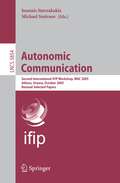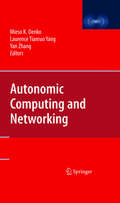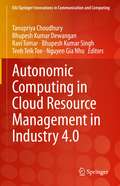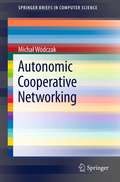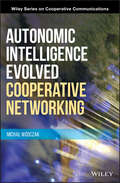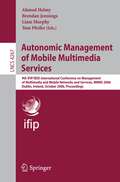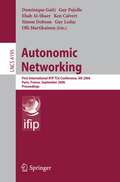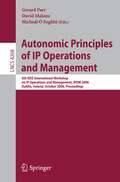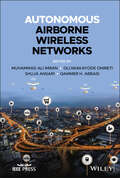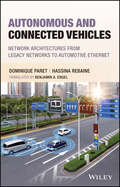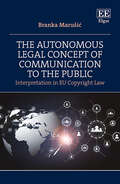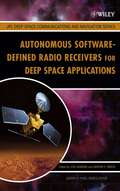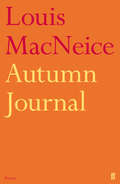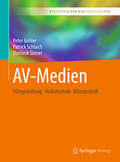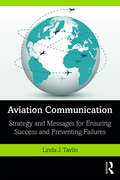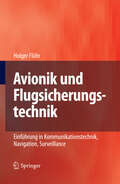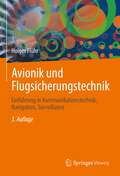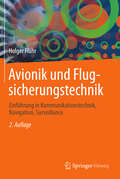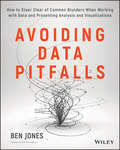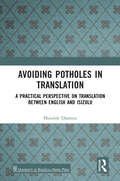- Table View
- List View
Autonomic Communication: Second International IFIP Workshop, WAC 2005, Athens, Greece, October 2-5, 2005, Revised Selected Papers (Lecture Notes in Computer Science #3854)
by Ioannis Stavrakakis Michael SmirnovThis book constitutes the thoroughly refereed post-proceedings of the Second International IFIP Workshop on Autonomic Communication, WAC 2005, held in Athens, Greece in October 2005. The 22 revised full papers presented together with one keynote paper, three invited papers and two panel summaries were carefully selected during two rounds of reviewing and improvement from numerous submissions. The papers discuss the principles of Autonomic Communication (AC).
Autonomic Computing and Networking
by Mieso Denko Laurence Tianruo Yang Yan ZhangAutonomic Computing and Networking presents introductory and advanced topics on autonomic computing and networking with emphasis on architectures, protocols, services, privacy & security, simulation and implementation testbeds. Autonomic computing and networking are new computing and networking paradigms that allow the creation of self-managing and self-controlling computing and networking environment using techniques such as distributed algorithms and context-awareness to dynamically control networking functions without human interventions. Autonomic networking is characterized by recovery from failures and malfunctions, agility to changing networking environment, self-optimization and self-awareness. The self-control and management features can help to overcome the growing complexity and heterogeneity of exiting communication networks and systems. The realization of fully autonomic heterogeneous networking introduces several research challenges in all aspects of computing and networking and related fields.
Autonomic Computing in Cloud Resource Management in Industry 4.0 (EAI/Springer Innovations in Communication and Computing)
by Tanupriya Choudhury Bhupesh Kumar Dewangan Ravi Tomar Bhupesh Kumar Singh Teoh Teik Toe Nguyen Gia NhuThis book describes the next generation of industry—Industry 4.0—and how it holds the promise of increased flexibility in manufacturing, along with automation, better quality, and improved productivity. The authors discuss how it thus enables companies to cope with the challenges of producing increasingly individualized products with a short lead-time to market and higher quality. The authors posit that intelligent cloud services and resource sharing play an important role in Industry 4.0 anticipated Fourth Industrial Revolution. This book serves the different issues and challenges in cloud resource management CRM techniques with proper propped solution for IT organizations. The book features chapters based on the characteristics of autonomic computing with its applicability in CRM. Each chapter features the techniques and analysis of each mechanism to make better resource management in cloud.
Autonomic Cooperative Networking (SpringerBriefs in Computer Science)
by Michał WódczakCooperative transmission aims to improve the reliability of wireless mobile communications through the use of diversity provided by additional relays assisting in the transmission between the source and destination nodes. This is possible as the rationale behind spatio-temporal processing can be easily mapped onto networked systems. Autonomic Cooperative Networking studies the further evolution of this phenomenon by first involving the network layer routines and then additionally incorporating the notion of autonomic system design.
Autonomic Intelligence Evolved Cooperative Networking (Wiley Series on Cooperative Communications)
by Michal WodczakAutonomic Intelligence Evolved Cooperative Networking offers a comprehensive advancement of the state-of-the art technological developments in the fields of Cooperative Networking and Autonomic Computing. Based on his track record in industrial standardisation, as well as academic and applied research, the author presents a fully-fledged Autonomic Cooperative Networking Architectural Model that encompasses the relevant workings of both the Layers of the Open Systems Interconnection Reference Model and the Levels of the Generic Autonomic Network Architecture. .
Autonomic Intelligence Evolved Cooperative Networking (Wiley Series on Cooperative Communications)
by Michal WodczakAutonomic Intelligence Evolved Cooperative Networking offers a comprehensive advancement of the state-of-the art technological developments in the fields of Cooperative Networking and Autonomic Computing. Based on his track record in industrial standardisation, as well as academic and applied research, the author presents a fully-fledged Autonomic Cooperative Networking Architectural Model that encompasses the relevant workings of both the Layers of the Open Systems Interconnection Reference Model and the Levels of the Generic Autonomic Network Architecture. .
Autonomic Management of Mobile Multimedia Services: 9th IFIP/IEEE International Conference on Management of Multimedia and Mobile Networks and Services, MMNS 2006, Dublin, Ireland, October 25-27, 2006, Proceedings (Lecture Notes in Computer Science #4267)
by Ahmed Helmy Brendan Jennings Liam Murphy Tom PfeiferThis book constitutes the refereed proceedings of the 9th IFIP/IEEE International Conference on Management of Multimedia and Mobile Networks and Services, MMNS 2006, held in Dublin, Ireland in October 2006 in the course of the 2nd International Week on Management of Networks and Services, Manweek 2006. The 18 revised full papers and six revised short papers presented were carefully reviewed and selected from 71 submissions.
Autonomic Networking: First International IFIP TC6 Conference, AN 2006, Paris, France, September 27-29, 2006, Proceedings (Lecture Notes in Computer Science #4195)
by Guy Pujolle Ehab Al-Shaer Ken Calvert Simon Dobson Guy Leduc Martikainen Dominique GaitiThis book constitutes the refereed proceedings of the First International IFIP TC6 Conference on Autonomic Networking, AN 2006. The 24 revised full papers presented were carefully reviewed and selected for inclusion in the book. The papers are organized in topical sections on autonomic networks, self-configuration, autonomic platform and services, autonomic management and discovery policy-based management, ad hoc, sensor and ambient autonomic networks, and autonomic control of mobile networks.
Autonomic Principles of IP Operations and Management: 6th IEEE International Workshop on IP Operations and Management, IPOM 2006, Dublin, Ireland, October 23-25, 2006, Proceedings (Lecture Notes in Computer Science #4268)
by Mícheál Ó Foghlú Gerard Parr David MaloneThis book constitutes the refereed proceedings of the 6th IEEE International Workshop on IP Operations and Management, IPOM 2006, held in Dublin, Ireland in October 2006 in the course of the 2nd International Week on Management of Networks and Services, Manweek 2006. The 18 revised full papers and four revised short papers presented were carefully reviewed and selected from 45 submissions.
Autonomous Airborne Wireless Networks (Wiley - IEEE)
by Muhammad Ali ImranDiscover what lies beyond the bleeding-edge of autonomous airborne networks with this authoritative new resource Autonomous Airborne Wireless Networks delivers an insightful exploration of recent advances in the theory and practice of using airborne wireless networks to provide emergency communications, coverage and capacity expansion, information dissemination, and more. The distinguished engineers and editors have selected resources that cover the fundamentals of airborne networks, including channel models, recent regulation developments, self-organized networking, AI-enabled flying networks, and notable applications in a variety of industries. The book evaluates advances in the cutting-edge of unmanned aerial vehicle wireless network technology while offering readers new ideas on how airborne wireless networks can support various applications expected of future networks. The rapidly developing field is examined from a fresh perspective, one not just concerned with ideas of control, trajectory optimization, and navigation. Autonomous Airborne Wireless Networks considers several potential use cases for the technology and demonstrates how it can be integrated with concepts from self-organized network technology and artificial intelligence to deliver results in those cases. Readers will also enjoy: A thorough discussion of distributed drone base station positioning for emergency cellular networks using reinforcement learning (AI-enabled trajectory optimization) An exploration of unmanned aerial vehicle-to-wearables (UAV2W) indoor radio propagation channel measurements and modelling An up-to-date treatment of energy minimization in UAV trajectory design for delay tolerant emergency communication Examinations of cache-enabled UAVs, 3D MIMO for airborne networks, and airborne networks for Internet of Things communications Perfect for telecom engineers and industry professionals working on identifying practical and efficient concepts tailored to overcome challenges facing unmanned aerial vehicles providing wireless communications, Autonomous Airborne Wireless Networks also has a place on the bookshelves of stakeholders, regulators, and research agencies working on the latest developments in UAV communications.
Autonomous Airborne Wireless Networks (Wiley - IEEE)
by Muhammad Ali Imran Oluwakayode Onireti Qammer H. AbbasiDiscover what lies beyond the bleeding-edge of autonomous airborne networks with this authoritative new resource Autonomous Airborne Wireless Networks delivers an insightful exploration of recent advances in the theory and practice of using airborne wireless networks to provide emergency communications, coverage and capacity expansion, information dissemination, and more. The distinguished engineers and editors have selected resources that cover the fundamentals of airborne networks, including channel models, recent regulation developments, self-organized networking, AI-enabled flying networks, and notable applications in a variety of industries. The book evaluates advances in the cutting-edge of unmanned aerial vehicle wireless network technology while offering readers new ideas on how airborne wireless networks can support various applications expected of future networks. The rapidly developing field is examined from a fresh perspective, one not just concerned with ideas of control, trajectory optimization, and navigation. Autonomous Airborne Wireless Networks considers several potential use cases for the technology and demonstrates how it can be integrated with concepts from self-organized network technology and artificial intelligence to deliver results in those cases. Readers will also enjoy: A thorough discussion of distributed drone base station positioning for emergency cellular networks using reinforcement learning (AI-enabled trajectory optimization) An exploration of unmanned aerial vehicle-to-wearables (UAV2W) indoor radio propagation channel measurements and modelling An up-to-date treatment of energy minimization in UAV trajectory design for delay tolerant emergency communication Examinations of cache-enabled UAVs, 3D MIMO for airborne networks, and airborne networks for Internet of Things communications Perfect for telecom engineers and industry professionals working on identifying practical and efficient concepts tailored to overcome challenges facing unmanned aerial vehicles providing wireless communications, Autonomous Airborne Wireless Networks also has a place on the bookshelves of stakeholders, regulators, and research agencies working on the latest developments in UAV communications.
Autonomous and Connected Vehicles: Network Architectures from Legacy Networks to Automotive Ethernet
by Dominique Paret Hassina RebaineAUTONOMOUS AND CONNECTED VEHICLES Discover the latest developments in autonomous vehicles and what the future holds for this exciting technology In Autonomous and Connected Vehicles, networking experts Dominique Paret and Hassina Rebaine deliver a robust exploration of the major technological changes taking place in the field, and describe the different levels of autonomy possible with current technologies and the legal and regulatory contexts in which new autonomous vehicles will circulate. The book also includes discussions of the sensors, including infrared, ultrasound, cameras, lidar, and radar, used by modern autonomous vehicles. Readers will enjoy the intuitive descriptions of Advanced Driver Assistance Systems (ADAS), network architectures (CAN-FD, FlexRay, and Backbone Ethernet), and software that power current and future autonomous vehicles. The authors also discuss how ADAS can be fused with data flowing over newer and faster network architectures and artificial intelligence to create greater levels of autonomy. The book also includes: A thorough introduction to the buzz and hype surrounding autonomous and connected vehicles, including a brief history of the autonomous vehicle Comprehensive explorations of common issues affecting autonomous and connected vehicles, including regulatory guidelines, legislation, relevant norms and standards, and insurance issues Practical discussions of autonomous vehicle sensors, from DAS to ADAS and HADAS, and VA L3 to L5 In-depth examinations of networks and architecture, including discussions of data fusion, artificial intelligence, and hardware architecture in vehicles Perfect for graduate and undergraduate students in programs dealing with the intersection of wireless communication technologies and vehicles, Autonomous and Connected Vehicles is also a must-read reference for industry professionals and researchers seeking a one-stop reference for the latest developments in vehicle communications technology.
Autonomous and Connected Vehicles: Network Architectures from Legacy Networks to Automotive Ethernet
by Dominique Paret Hassina RebaineAUTONOMOUS AND CONNECTED VEHICLES Discover the latest developments in autonomous vehicles and what the future holds for this exciting technology In Autonomous and Connected Vehicles, networking experts Dominique Paret and Hassina Rebaine deliver a robust exploration of the major technological changes taking place in the field, and describe the different levels of autonomy possible with current technologies and the legal and regulatory contexts in which new autonomous vehicles will circulate. The book also includes discussions of the sensors, including infrared, ultrasound, cameras, lidar, and radar, used by modern autonomous vehicles. Readers will enjoy the intuitive descriptions of Advanced Driver Assistance Systems (ADAS), network architectures (CAN-FD, FlexRay, and Backbone Ethernet), and software that power current and future autonomous vehicles. The authors also discuss how ADAS can be fused with data flowing over newer and faster network architectures and artificial intelligence to create greater levels of autonomy. The book also includes: A thorough introduction to the buzz and hype surrounding autonomous and connected vehicles, including a brief history of the autonomous vehicle Comprehensive explorations of common issues affecting autonomous and connected vehicles, including regulatory guidelines, legislation, relevant norms and standards, and insurance issues Practical discussions of autonomous vehicle sensors, from DAS to ADAS and HADAS, and VA L3 to L5 In-depth examinations of networks and architecture, including discussions of data fusion, artificial intelligence, and hardware architecture in vehicles Perfect for graduate and undergraduate students in programs dealing with the intersection of wireless communication technologies and vehicles, Autonomous and Connected Vehicles is also a must-read reference for industry professionals and researchers seeking a one-stop reference for the latest developments in vehicle communications technology.
The Autonomous Legal Concept of Communication to the Public: Interpretation in EU Copyright Law
by Branka MarušićThe economic right of a copyright holder to communicate to the public has become an increasingly important and complex issue in recent years, this is partially due to changes in the way that content is accessed and consumed online. This innovative book analyses the right of communication to the public, taking account of what legal standing an autonomous legal concept can hold, and how this is impacted by wider harmonisation efforts at an EU level.The book explores the scope of the right of communication to the public in a twofold manner: Firstly, it examines the legal standing and effect, from a constitutional perspective of an autonomous legal concept. Secondly, it analyses CJEU case law, grouping cases by type of communication model to demonstrate what kind of authorisation is required to permit widened communication to the public online. Marušic builds on both strands of analysis to propose an operational model of communication for future use, that can aid in identifying and remedying infringements.Providing novel analysis on the definition and status of autonomous legal concepts in the EU, and setting this analysis against the context of harmonisation processes, this book will be of great interest to scholars working in both copyright law and EU law more widely.
Autonomous Software-Defined Radio Receivers for Deep Space Applications (JPL Deep-Space Communications and Navigation Series #13)
by Joseph H. YuenThis book introduces the reader to the concept of an autonomous software-defined radio (SDR) receiver. Each distinct aspect of the design of the receiver is treated in a separate chapter written by one or more leading innovators in the field. Chapters begin with a problem statement and then offer a full mathematical derivation of an appropriate solution, a decision metric or loop-structure as appropriate, and performance results.
Autumn Journal: Poem (Faber Poetry Ser.)
by Louis MacNeiceWritten between August and December 1938, Autumn Journal is still considered one of the most valuable and moving testaments of living through the thirties by a young writer. It is a record of the author's emotional and intellectual experience during those months, the trivia of everyday living set against the events of the world outside, the settlement in Munich and slow defeat in Spain.
AV-Medien: Filmgestaltung – Audiotechnik – Videotechnik (Bibliothek der Mediengestaltung)
by Peter Bühler Patrick Schlaich Dominik SinnerDieser Band der „Bibliothek der Mediengestaltung“ behandelt die filmgestalterischen und technischen Grundlagen für AV-Produktionen für den Einsatz von Audio und Video in Digitalmedien.Für diese Bibliothek wurden die Themen des Kompendiums der Mediengestaltung neu strukturiert, vollständig überarbeitet und in ein handliches Format gebracht. Leitlinien waren hierbei die Anpassung an die Entwicklungen in der Werbe- und Medienbranche sowie die Berücksichtigung der aktuellen Rahmenpläne und Studienordnungen sowie Prüfungsanforderungen der Ausbildungs- und Studiengänge.Die Bände der „Bibliothek der Mediengestaltung“ enthalten zahlreiche praxisorientierte Aufgaben mit Musterlösungen und eignen sich als Lehr- und Arbeitsbücher an Schulen sowie Hochschulen und zum Selbststudium.
Aviation Communication: Strategy and Messages for Ensuring Success and Preventing Failures
by Linda J. TavlinDo you ever wonder why an airline’s communication strategy can crash and burn in a crisis? A lack of understanding an acceptable aviation communication strategy can, in this fast world of social media, ruin a company’s credibility in the aviation industry. Aviation Communication: Strategy and Messages for Ensuring Success and Preventing Failures is the first go-to book to reveal to everyone in the aviation industry how to stop an organization’s communication strategy from becoming the tragedy-after-the-tragedy that we’ve seen so often. In such instances, after the media go home, the economic, political, regulatory, and legal effects can linger for years. The strategies and messages in this book show how to prevent this along with the ultimate safety net used by those who have been successful. Readers will learn to prevent catastrophic communication mistakes with strategic templates for a wide array of scenarios, as well as 25 specific techniques that give the actual words to use to deliver the book’s messages. This book is a must-have for the international aviation business community as a tri-functional induction, training, and reference tool.
Aviation Communication: Strategy and Messages for Ensuring Success and Preventing Failures
by Linda J. TavlinDo you ever wonder why an airline’s communication strategy can crash and burn in a crisis? A lack of understanding an acceptable aviation communication strategy can, in this fast world of social media, ruin a company’s credibility in the aviation industry. Aviation Communication: Strategy and Messages for Ensuring Success and Preventing Failures is the first go-to book to reveal to everyone in the aviation industry how to stop an organization’s communication strategy from becoming the tragedy-after-the-tragedy that we’ve seen so often. In such instances, after the media go home, the economic, political, regulatory, and legal effects can linger for years. The strategies and messages in this book show how to prevent this along with the ultimate safety net used by those who have been successful. Readers will learn to prevent catastrophic communication mistakes with strategic templates for a wide array of scenarios, as well as 25 specific techniques that give the actual words to use to deliver the book’s messages. This book is a must-have for the international aviation business community as a tri-functional induction, training, and reference tool.
Avionik und Flugsicherungstechnik: Einführung in Kommunikationstechnik, Navigation, Surveillance
by Holger FlührDas Lehrbuch spannt den Bogen von Flugsicherungs-Technologien über Avioniksysteme (Kommunikation, Navigation, Surveillance) sowie die bordautonome Energieversorgung bis hin zur Integration der Systeme im Flugzeug. Neben der Beschreibung von Funktion und Aufbau der Teilsysteme behandelt der Autor deren Einbindung in die Avionikumgebung des Flugzeugs und die Bodeninfrastruktur. Notwendiges nachrichtentechnisches Wissen wird wiederholt, die Definition von Lernzielen, Verständnisfragen und beispielhafte Aufgaben sichern den Lernerfolg.
Avionik und Flugsicherungstechnik: Einführung in Kommunikationstechnik, Navigation, Surveillance
by Holger FlührDas Buch spannt den Bogen von modernen Technologien zur Flugsicherung über die wesentlichen Avioniksysteme (Kommunikation, Navigation, Surveillance) sowie die bordautonome Energieversorgung bis hin zur Integration der Systeme im Flugzeug. Der Autor legt Wert auf die Einbindung der vorgestellten Funktionsblöcke in das System Flugzeug bzw. in das System Luftfahrt: Er behandelt sowohl Funktion und Aufbau der Teilsysteme als auch deren Einbindung in die Avionikumgebung des Flugzeugs und in die Bodeninfrastruktur. Ein weiteres Thema sind zulassungsspezifische Fragestellungen. Zum Verständnis notwendige nachrichtentechnische Kenntnisse werden komprimiert wiederholt. Der Lernerfolg wird durch Definition von Lernzielen, Verständnisfragen und Beispielaufgaben sichergestellt. Die 2., komplett durchgesehene Auflage erweitert vor allem die Ausführungen zur Zuverlässigkeit von Flugzeugsystemen und lässt aktuelle Entwicklungen wie etwa SESAR in den Text einfließen.
Avionik und Flugsicherungstechnik: Einführung in Kommunikationstechnik, Navigation, Surveillance
by Holger FlührDas Buch spannt den Bogen von modernen Technologien zur Flugsicherung über die wesentlichen Avioniksysteme (Kommunikation, Navigation, Surveillance) sowie die bordautonome Energieversorgung bis hin zur Integration der Systeme im Flugzeug. Der Autor legt Wert auf die Einbindung der vorgestellten Funktionsblöcke in das System Flugzeug bzw. in das System Luftfahrt: Er behandelt sowohl Funktion und Aufbau der Teilsysteme als auch deren Einbindung in die Avionikumgebung des Flugzeugs und in die Bodeninfrastruktur. Ein weiteres Thema sind zulassungsspezifische Fragestellungen. Zum Verständnis notwendige nachrichtentechnische Kenntnisse werden komprimiert wiederholt. Der Lernerfolg wird durch Definition von Lernzielen, Verständnisfragen und Beispielaufgaben sichergestellt. Die 2., komplett durchgesehene Auflage erweitert vor allem die Ausführungen zur Zuverlässigkeit von Flugzeugsystemen und lässt aktuelle Entwicklungen wie etwa SESAR in den Text einfließen.
Avoiding Data Pitfalls: How to Steer Clear of Common Blunders When Working with Data and Presenting Analysis and Visualizations
by Ben JonesAvoid data blunders and create truly useful visualizations Avoiding Data Pitfalls is a reputation-saving handbook for those who work with data, designed to help you avoid the all-too-common blunders that occur in data analysis, visualization, and presentation. Plenty of data tools exist, along with plenty of books that tell you how to use them—but unless you truly understand how to work with data, each of these tools can ultimately mislead and cause costly mistakes. This book walks you step by step through the full data visualization process, from calculation and analysis through accurate, useful presentation. Common blunders are explored in depth to show you how they arise, how they have become so common, and how you can avoid them from the outset. Then and only then can you take advantage of the wealth of tools that are out there—in the hands of someone who knows what they're doing, the right tools can cut down on the time, labor, and myriad decisions that go into each and every data presentation. Workers in almost every industry are now commonly expected to effectively analyze and present data, even with little or no formal training. There are many pitfalls—some might say chasms—in the process, and no one wants to be the source of a data error that costs money or even lives. This book provides a full walk-through of the process to help you ensure a truly useful result. Delve into the "data-reality gap" that grows with our dependence on data Learn how the right tools can streamline the visualization process Avoid common mistakes in data analysis, visualization, and presentation Create and present clear, accurate, effective data visualizations To err is human, but in today's data-driven world, the stakes can be high and the mistakes costly. Don't rely on "catching" mistakes, avoid them from the outset with the expert instruction in Avoiding Data Pitfalls.
Avoiding Data Pitfalls: How to Steer Clear of Common Blunders When Working with Data and Presenting Analysis and Visualizations
by Ben JonesAvoid data blunders and create truly useful visualizations Avoiding Data Pitfalls is a reputation-saving handbook for those who work with data, designed to help you avoid the all-too-common blunders that occur in data analysis, visualization, and presentation. Plenty of data tools exist, along with plenty of books that tell you how to use them—but unless you truly understand how to work with data, each of these tools can ultimately mislead and cause costly mistakes. This book walks you step by step through the full data visualization process, from calculation and analysis through accurate, useful presentation. Common blunders are explored in depth to show you how they arise, how they have become so common, and how you can avoid them from the outset. Then and only then can you take advantage of the wealth of tools that are out there—in the hands of someone who knows what they're doing, the right tools can cut down on the time, labor, and myriad decisions that go into each and every data presentation. Workers in almost every industry are now commonly expected to effectively analyze and present data, even with little or no formal training. There are many pitfalls—some might say chasms—in the process, and no one wants to be the source of a data error that costs money or even lives. This book provides a full walk-through of the process to help you ensure a truly useful result. Delve into the "data-reality gap" that grows with our dependence on data Learn how the right tools can streamline the visualization process Avoid common mistakes in data analysis, visualization, and presentation Create and present clear, accurate, effective data visualizations To err is human, but in today's data-driven world, the stakes can be high and the mistakes costly. Don't rely on "catching" mistakes, avoid them from the outset with the expert instruction in Avoiding Data Pitfalls.
Avoiding Potholes in Translation: A Practical Perspective on Translation between English and isiZulu
by Phindile DlaminiThis book is a comprehensive introduction to translation studies between English and isiZulu. It incorporates crucial concepts for understanding the basics of translation within a South African language context and lays a foundation for further studies in translation. The book's content coverage, while broad, is also in-depth, and it skillfully integrates examples from varied types of texts. The practical and accessible style makes it both engaging and informative. The diverse examples illustrate not only the technicalities of translation as a process, but the vivid dynamics brought about by the fact that the languages involved in the translation process belong to different language families. The use of these examples for almost every aspect of translation explained makes this book unique and valuable to translation scholars and practitioners alike. Even though the book uses cases from the isiZulu language, it is an applicable reference for translation scholars and practitioners working with different indigenous languages of South Africa. Print edition not for sale in Sub Saharan Africa.
